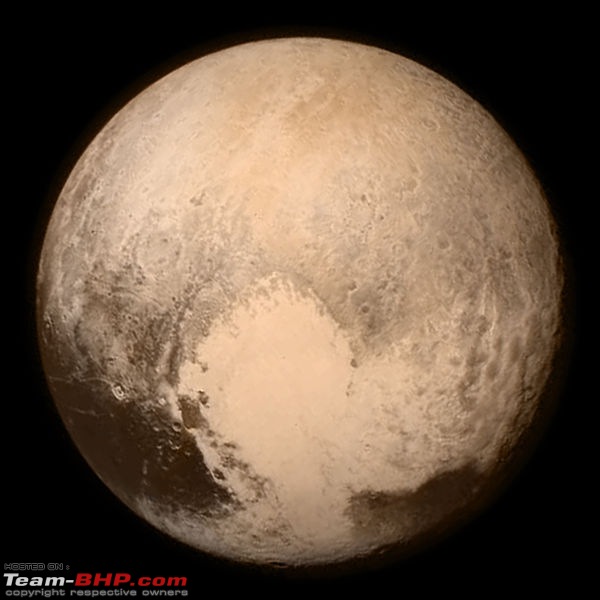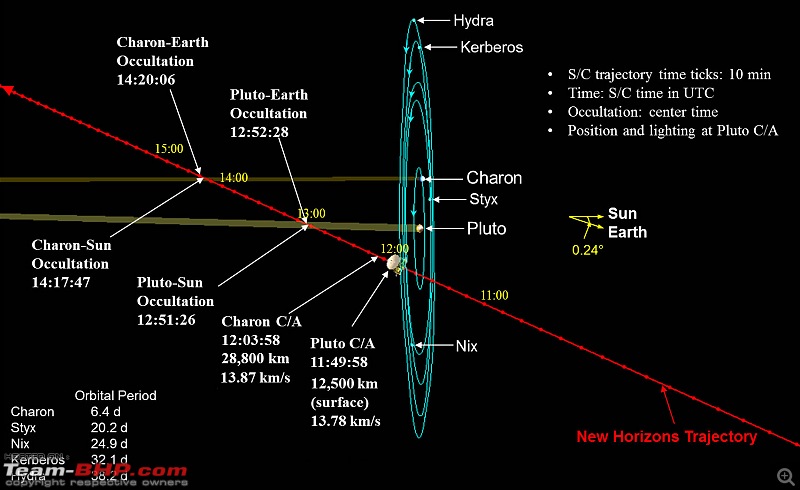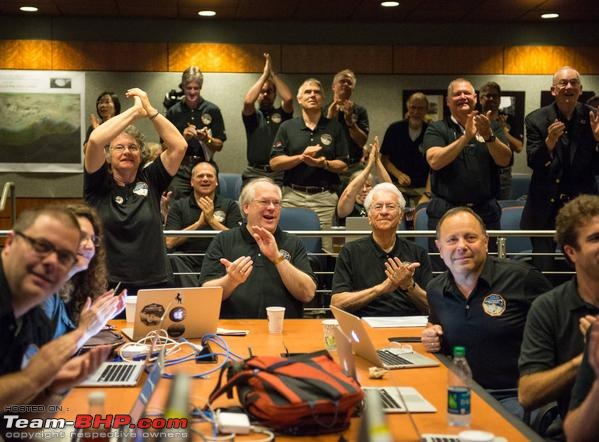As many of you might now, today is a historic day for space exploration and science in general.
Last picture before closest approach 
Because today, New Horizons, a grand piano sized spacecraft will make its closest approach to Pluto and by doing so, it will become the only manmade object to come anywhere close to Pluto and study it. Thus, we as human beings can lay claim to the fact that we have visited all the first 9 planets of our solar system. Its a monumental achievement!
Pluto and Charon, imaged a few days back 
Pluto has been over the years become more infamous for being 'Planet that never was'. There always will be two parties to this debate. One who insists it was wrong to strip Pluto the title of a 'Planet', and other who puts forward evidence of bodies much larger than Pluto in our Solar System orbiting the Sun.
The main reason why Pluto was stripped of the title was due to 'Eris', a planetoid a shade larger than Pluto and the direct first evidence of the 'Kuiper Belt'.

The Kuiper Belt is fascinating. Think of it as the asteroid belt, but many many times bigger. The distance of the Earth from the Sun is taken as 1 Astronomical Unit which 150 million kms. Pluto lies on an average 30AU from the Sun. The Kuiper Belt starts 20AU from Pluto! Its primarily filled up with smaller bodies the size of asteroids, but now as we know, its also the home of a large number of smaller planets, often 1000+kms in diameter.
Many of these 'Dwarf Planets' revolve around the Sun in huge orbits. There is a world called 'Sedna', whose color is dark deep red which takes 11,400 years to complete an orbit of the Sun!

Eris, which is larger than Pluto, takes almost 600 years to complete an orbit. Same with other planetoids like 'Makemake' and 'Haumea' which are the other inhabitants of the Kuiper Belt. There are many more but our space telescopes are not powerful enough to discern them all and we will need more specialized telescopes for them.

New Horizons is not going to stop at Pluto. Its going to race by at full speed. It might sound weird that after travelling so far and for so many years, we will get just a few hours of scientific data from Pluto, passing by 12,500 kms away from the surface at its closest approach. As I write this, its already past Pluto and closing in on Charon, its largest moon.

After it goes some way past the Pluto system, it will train its antenna back to earth and start sending all the data. Because of the immense distances, it will take a couple of hours for information travelling at the speed of light to reach us. Hence the spectacular images will come in a while and not now.
The reason why it wont get into orbit around Pluto is because of the immense amount of energy required to 'Throw' something so far away and then again, spend energy in slowing it down to go into orbit. Requires a lot of fuel, or in space orbital-talk, a lot of Delta-V/change of velocity.

Spacetime is basically like this huge blanket. In the middle of this blanket is our Sun, and just as you put a rather heavy ball on the blanket but hold the edges up, the blanket will sag in the middle. This is the 'Gravity Well'. Imagine trying to roll up something along the edges of this blanket. Then imagine trying to roll up something along the edge of this blanket so fast that it flies off the top and escapes the blanket and hence, our Solar System. That is called the Sun-escape velocity which is what was done to New Horizons.

It was given an almighty push to escape Earth first. New Horizons was the fastest spacecraft ever to leave Earth. An absolute pedal-to-the-metal LC start. 0-59,000 kmph in a few minutes.

. It passed Moon in a couple of hours. It reached Jupiter within a year! In fact, it spent a lot of time studying Jupiter as it sped past, training its very advanced instruments to gather priceless data.
Image of Jupiter from NH 
And the iconic image of a volcano erupting in Io, and spewing material to space!

Because of the quirks of our radio communication abilities, it sent back more data from Jupiter than it will from the far reaches of Pluto.
It dipped into Jupiter's gravity well and got a 'Slingshot' to increase its speed even more for a faster Pluto rendezvous. Even then, it took 9 long years to reach Pluto...
Brave little New Horizons. This space probe was the dream of scientists since the 70s. Voyager probes had a plan to go to Pluto during the 'Grand Tour', but was diverted to make a pass of Saturn's moon Titan and hence could never go to Pluto.

After many proposals, budgetary cuts, demotion of Pluto, many scientists have passed away while building on their dreams of reaching Pluto. Today, it finally did! Its amazing that the cost of New Horizons will not even cover a cost of a new missile development, but funds for space are hard to find (and for war much easier).

Other than cameras, it is packed with other instruments like spectrometers to study Pluto in all wavelengths of light to study its surface materials and atmosphere constituents. As it goes past Pluto, it will 'Occult', that is, Pluto will block out the sun and its atmosphere can be studied.

It will study Charon, its largest moon and the smaller moons Nix, Hydra, Styx and Kerberos.
After that, it will continue on its way and will probably make a flyby on another Kuiper Belt object, the targets were still being determined well after New Horizons was on its way. As of now, a smaller object around 70kms in Diameter is the target and it wont reach it for another few years I guess.
After that, it will join Pioneer 1, Pioneer 2, Voyager 1 and Voyager 2 as the 5th spacecraft to leave the Solar System and become Interstellar.

Cant wait for the data to come streaming in!
















 . It passed Moon in a couple of hours. It reached Jupiter within a year! In fact, it spent a lot of time studying Jupiter as it sped past, training its very advanced instruments to gather priceless data.
. It passed Moon in a couple of hours. It reached Jupiter within a year! In fact, it spent a lot of time studying Jupiter as it sped past, training its very advanced instruments to gather priceless data.









